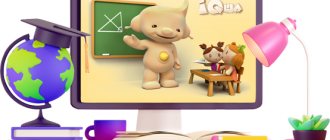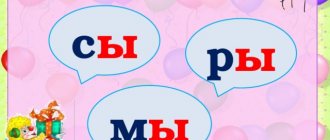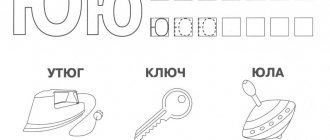Certificate for children
Learning to read is one of the most important tasks for a preschooler. Having mastered this skill, the child will be able to independently explore the world with the help of books and find answers to his questions.
Development and education of children from 2 to 11 years old in a playful way
Start practicing right now
Start practicing
However, this is not so easy to learn. We suggest using game techniques that will help turn a difficult learning process into an exciting quest.
Literacy training in the senior group
It is at the age of 5-6 years that children usually begin to actively teach literacy and spend time developing speech: distinguishing sounds and letters, reading individual words and sentences, putting emphasis.
Preschoolers learn to find the right words to name objects in pictures, make sentences, and draw diagrams of words.
Children also train and prepare their hands for writing: they draw and paint a lot, shade, trace the contours of objects, and learn to write letters little by little.
A child’s enrollment in school is an important stage in life, which changes the social situation of his development. It is necessary to prepare the child for studying in the 1st grade. It is important that children of 7 years of age master, first of all, competent phrases, detailed speech, the amount of knowledge, abilities, skills determined by the program of the preparatory group of general preschool institutions. Kindergarten is the first stage in the public education system and performs an important function in preparing children for school.
Correct speech is one of the indicators of a child’s readiness to learn at school, the key to successful mastery of literacy and reading: after all, written speech is formed on the basis of oral speech, and children suffering from general underdevelopment of speech and phonemic hearing are potential dysgraphics and dyslexics (children with impairments in writing and reading).
The main task in the process of teaching literacy is to form in preschoolers a general orientation in the sound system of the language, teaching them the sound analysis of words, i.e. determining the order of sounds in a word, establishing the distinctive role of sound, its main qualitative characteristics.
The process of learning to read and write offers various forms: in one case it is a game, in another it is a performance activity, where children are both participants in the performance and spectators, in the third they are teachers, not students, etc. Various options for activities have been invented using: literary characters, specially made panels; fairy tale plots; elements of a plot-didactic game; plot paintings, etc.
Such forms of work make it possible to achieve stable attention and maintain interest in children-speech therapists. And this is important if we consider that, on the one hand, children have an unstable psyche, on the other hand, in the conditions of a long winter they experience an unstable psycho-emotional state, decreased performance and rapid fatigue.
The plot-thematic organization of the learning process and variety in the presentation of educational material contributed to the spontaneous development of coherent speech, maintaining a positive emotional state of children, interest and attention, and therefore better performance in learning knowledge. The positive aspects are that the tasks are aimed at including all analyzer systems in operation.
Let us consider in more detail the options for using correctional and developmental games and techniques that give the greatest effect in preparation for learning to read and write.
Children cannot master phonics by just saying words out loud. Therefore, when teaching literacy to older preschoolers, it is necessary to use a variety of means that allow them to perceive information visually.
Using entertaining visual material when working with preschoolers is one of the main keys to successfully teaching children abstract concepts in literacy. It is not easy for a child to understand what a sound, syllable, word, sentence is if the teacher’s explanations are not supported by illustrative material.
Getting acquainted with the sounds of speech should begin with considering the position of the organs of articulation during the utterance of a particular sound, correlating one’s own kinesthetic sensations with the images on the speech profiles. Then the children are asked to characterize the sound being studied, selecting the necessary symbols.
A girl in a red dress symbolizes a vowel sound, a blue dress symbolizes a hard consonant, and a green dress symbolizes a soft consonant. The hammer is a hard consonant, the feather is a soft consonant. Ushko is a voiceless consonant, bell is a voiced consonant.
In addition to the generally accepted designations of sounds with colored circles, when becoming familiar with vowel sounds, you can use symbols that provide support for the articulation of sound. Thus, the sound [a] is indicated by a red circle with a wide open mouth, the sound [y] is indicated by a circle with a small round mouth, the sound [i] is indicated by lips stretched out in a smile. The symbols for the sounds [s] and [e] indicate the position of the tongue in the oral cavity.
The use of this visual material is advisable at all stages of work on studying speech sounds. This includes the isolated pronunciation of sounds, the compilation of sound patterns and syllables, the determination of the position of a particular sound in a word, and the selection of pictures for “encrypted” words.
By offering this type of work, we go from simple to complex. At the initial stage, you need to choose which picture fits the diagram. In the future, the task becomes more complicated: pictures and diagrams are added. The creation of game situations contributes to more successful completion of tasks. For example, based on the diagrams depicted on each ship, children determine what fruits were brought on them; find out who or what the chickens saw in the clearing; what the driver is transporting in the container; they seat trained animals on pedestals in the circus, etc.
The manual “Steam Locomotive”, “House” is also used to determine the position of sounds in a word. Children place pictures in carriages corresponding to the position of a given sound in a word. In the 1st car, pictures are placed in the names of which the sound being studied is at the beginning of the word, in the 2nd car - with the sound being studied in the middle of the word; in the 3rd - with a given sound at the end of the word.
When differentiating sounds, children not only identify objects, but also group them according to certain characteristics: hardness - softness, deafness - sonority.
The use of visual material plays an important role when working on syllable division. When dividing words into syllables, we use techniques aimed at the joint activity of the auditory, visual and kinesthetic analyzers. For example, in the “Cart” exercise, children read a word, divide it into parts, and load as many bags into the cart as there are syllables in the word read. In the same way, children practice dividing words into syllables by playing store, where the first syllable in the name of the product is equal to one coin.
When becoming familiar with the graphic designation of the sound being studied, it is necessary to connect its phonetic image with the visual one. This is possible only when children clearly understand: the main difference between a sound and a letter is that we hear sounds, but we see, write and read letters. To achieve this task, various task options are used.
In addition to the generally accepted techniques, children most like to depict letters from colored sand, draw them on the sand with a finger and a stick, trace letters made from sandpaper or semolina glued to paper with their finger, construct them with their hands, lay them out from sticks, threads, fruits, and mosaics.
In addition, to compose and read words from well-known “scattered” letters or syllables, it is necessary to fill in the missing letter - the game “Give a Pill to Grandfather Bukvoed”, to assemble a word from rearranged or mixed up letters - the game “Unscramble the Word”, to read words from the initial letters of the proposed objects - the game “Read by the first letter”, as well as words in which one letter was replaced by another in order to change the phonetic sound and meaning (cat - porridge, jackdaw - stick, kidney - barrel).
More complex tasks for children - crosswords, puzzles - the game "Funny Puzzles" and games like "Field of Miracles", the game "Lucky Chance", quizzes.
When learning to synthesize syllables from letters in class, various game situations are created: feed Carlson jam from two jars (one of them contains strawberries with consonants, the other with vowels); take part in a circus act in which a clown juggles acorns, etc.
When making words from letters, children complete tasks based on the size of an object with a letter depicted on it, and arrange the pictures in ascending and descending order; form words from given letters and syllables.
For the purpose of propaedeutics of mirroring in writing, preschoolers are taught to distinguish between correctly and mirrored letters. Children look for a given letter from a number of other letters in words and phrases. Correctly written letters are isolated and circled, words and sentences are composed from them, and elements are added to complete the image of the letter.
The methods for working on a proposal are varied. At the initial stage, these are answers to questions based on pictures. In the future, using the game “Phrase Constructor”, where we solve various problems.
Children become familiar with the concepts of “words-objects”, “words-actions”, “words-features”, “prepositions”. Each concept is indicated by a specific symbol. Words-objects are depicted on white cards, words-actions are in motion, words-signs are striped. Each picture can have several interpretations. For example, “girl, sister, daughter.” A picture with a glass can mean “tea, juice, compote,” etc.
During the game, children compose various sentences, first from two words, and then add attribute words denoting color, shape, size, emotions, homogeneous additions, conjunctions and prepositions.
In parallel with the assimilation of lexical-syntactic relations between members of sentences, it is necessary to carry out work on the analysis and synthesis of the verbal composition of the sentence. In this case, first use house strips (at the initial stage), later stripes to indicate words, and sketch diagrams in notebooks. With great interest, children build sentences in the game “Live Sentences”, come up with sentences using a cube, on the sides of which the number of words in the sentence is indicated.
When working on a phrase becomes more difficult, children are asked to restore the deformed sentence. Depending on the game situation created during the lesson, they read the words written in the pictures and make sentences from them. Particular emphasis when performing this type of task is on finding the first word written with a capital letter and placing a period at the end of the sentence.
Play for a child is an opportunity for self-expression, self-testing, and self-determination. The game situation requires from everyone included in it a certain ability to communicate, promotes sensory and mental development (visual perception, figurative representations, learning to analyze), assimilation of lexical and grammatical categories of the native language, and also helps to consolidate and enrich acquired knowledge based on which speech abilities develop.
K.D. Ushinsky believed that the development of speech can only be carried out in activity, only in exercises that should be as independent as possible, systematic, logical, oral and written, and oral should precede written ones. Ushinsky considered the development of speech as the formation of a skill. “In every word that we pronounce, in every movement of the hand in writing... there is certainly its own share of skill, a share of a more or less ingrained reflex.” For the strength of a skill, in his opinion, time, patience, effort, gradualness and consistency are required. Following the guidelines of a classic teacher, we must first of all interest students, convey information to them in a form in which they are able to perceive it, taking into account their age characteristics. That is why the use of visual material in the process of teaching literacy to preschool children is one of the main requirements in working with older preschoolers.




